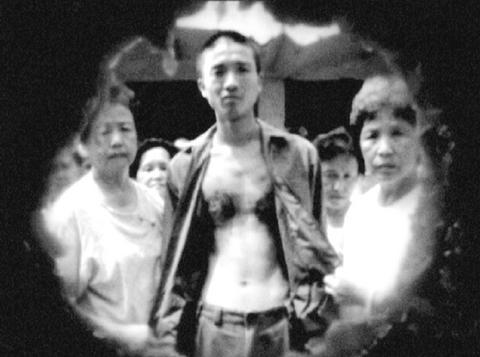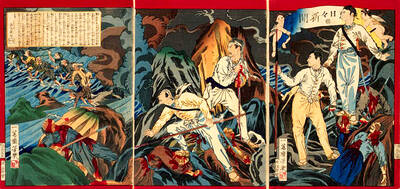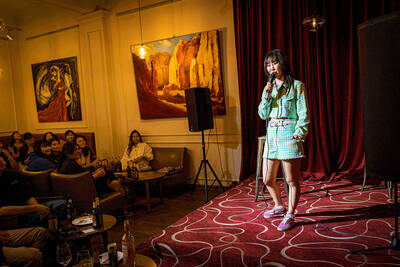Chen Chieh-jen (
The piece, which screens tonight, was chosen to take part in the festival's "Death, Be Not Proud" section and is likely to stir controversy and emotions, much as it does when displayed in museums.

PHOTO COURTESY OF TIDF
Over the past decade, Chen has emerged as one of Taiwan's leading artists, with an approach that is as disturbing as it is thought-provoking. Using computer-manipulated montages, he creates what appear to be historical photographs and videos of instances of obscene brutality that comment on recent history. Filling his images are dismembered bodies and laughing, disfigured humans against backgrounds of post-apocalyptic desolation.

PHOTO COURTESY OF TIDF
As a video of the gory form of Qing-dynasty execution called the 10,000 cuts, Lingchi epitomizes these violent visual themes. Based on a single photograph taken by a French military officer in China at the beginning of the 1900s, the video is a silent, slow-motion, black-and-white movie of a man being slowly dismembered. Though the cuts are staged and stylized, they leave little to the imagination and make for some upsetting viewing.
Interjecting the execution scenes are shots of other locations of famous historical atrocities, such as Beijing's Summer Palace, where rampaging Western troops destroyed one of China's most ornate structures in 1900. And Green Island, where petty criminals and political dissidents were sent by the Chinese Nationalist Party (KMT) to languish or be executed during Taiwan's long period of martial law that ended in 1987.
The images link instances of human brutality through the ages to show that the potential for inhumane behavior remains a historical constant. It suggests that there is something within us as humans that leads us to brutality against each other.
The images also display the abuse of the subjugated at the hands of ruling entities, whether they be individuals, states or any other hegemonic power. This turns the film into a critique of familiar power struggles -- rich and poor, West and East, First World and Third World, etc.
To add an extra layer to the piece's themes of abuse, Chen chose as actors former employees of the American electronics company RCA, which once operated a television-manufacturing plant in Taiwan that was later proven to have sub-standard health conditions. Many of the former employees contracted cancer.
The issue of compensation from RCA has lingered as a controversy ever since, while the factory has come to symbolize in Taiwan the predatorial manner of global capitalism. The RCA case is further complicated by the implicit political and racial element of the American company's abuse of cheap labor.
These various tensions are brought into stark focus in the filming of the execution, as the powerful take apparent pleasure in the slow killing of a helpless man.
Film festival notes:
What: The 4th Taiwan International
Documentary Festival.
When: Until Friday.
Where: Showtime Cinema (欣欣晶華影城),
247 Linsen N Rd, Taipei (台北市林森北路247號).
Spot-Taipei Film House (光點台北),
18 Zhongshan N Rd, Sec 2, Taipei
(台北市中山北路二段18號).
Shih-ming Hall of Taiwan Cement
Building (台泥大樓士敏廳)113 Zhongshan N Rd, Sec 2, Taipei (台北市中山北路二段113號).
Huashan Creative Arts and Industry Center (華山文化園區), for outdoor screenings only, 1 Bade Rd, Sec 1, Taipei (台北市八德路一段號)
Tickets: NT$10, available at SPOT - Taipei Film House.
On the web: www.tidf.org.tw
凌遲考:一張歷史照片的迴音
陳界仁
台灣
2002台北雙年展
2004溫哥華國際影展
2004倫敦電影節
本片根據法國軍隊於1900年代初,在中國拍攝的一張凌遲行刑現場的歷史照片加以重建再現。創作的目的並非為了考據或重回現場,而是針對凌遲的形式,重新加以凝視與再現,並將其擴大演繹為一道隱喻,影射全球化意圖下的第一世界霸權,之於弱勢者的權力關係。已成歷史遺跡與廢墟的北京圓明園、哈爾濱731遺址、綠島的綠洲山莊、桃園RCA電子加工廠與充當演員的工殤與失業勞工,也幾乎無一不是長期遭受凌遲肆虐的無助受難者。(節錄自王嘉驥之文)

In the March 9 edition of the Taipei Times a piece by Ninon Godefroy ran with the headine “The quiet, gentle rhythm of Taiwan.” It started with the line “Taiwan is a small, humble place. There is no Eiffel Tower, no pyramids — no singular attraction that draws the world’s attention.” I laughed out loud at that. This was out of no disrespect for the author or the piece, which made some interesting analogies and good points about how both Din Tai Fung’s and Taiwan Semiconductor Manufacturing Co’s (TSMC, 台積電) meticulous attention to detail and quality are not quite up to

April 21 to April 27 Hsieh Er’s (謝娥) political fortunes were rising fast after she got out of jail and joined the Chinese Nationalist Party (KMT) in December 1945. Not only did she hold key positions in various committees, she was elected the only woman on the Taipei City Council and headed to Nanjing in 1946 as the sole Taiwanese female representative to the National Constituent Assembly. With the support of first lady Soong May-ling (宋美齡), she started the Taipei Women’s Association and Taiwan Provincial Women’s Association, where she

It is one of the more remarkable facts of Taiwan history that it was never occupied or claimed by any of the numerous kingdoms of southern China — Han or otherwise — that lay just across the water from it. None of their brilliant ministers ever discovered that Taiwan was a “core interest” of the state whose annexation was “inevitable.” As Paul Kua notes in an excellent monograph laying out how the Portuguese gave Taiwan the name “Formosa,” the first Europeans to express an interest in occupying Taiwan were the Spanish. Tonio Andrade in his seminal work, How Taiwan Became Chinese,

Mongolian influencer Anudari Daarya looks effortlessly glamorous and carefree in her social media posts — but the classically trained pianist’s road to acceptance as a transgender artist has been anything but easy. She is one of a growing number of Mongolian LGBTQ youth challenging stereotypes and fighting for acceptance through media representation in the socially conservative country. LGBTQ Mongolians often hide their identities from their employers and colleagues for fear of discrimination, with a survey by the non-profit LGBT Centre Mongolia showing that only 20 percent of people felt comfortable coming out at work. Daarya, 25, said she has faced discrimination since she